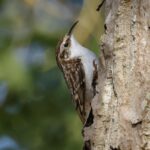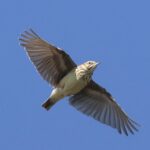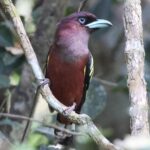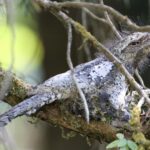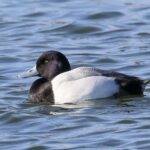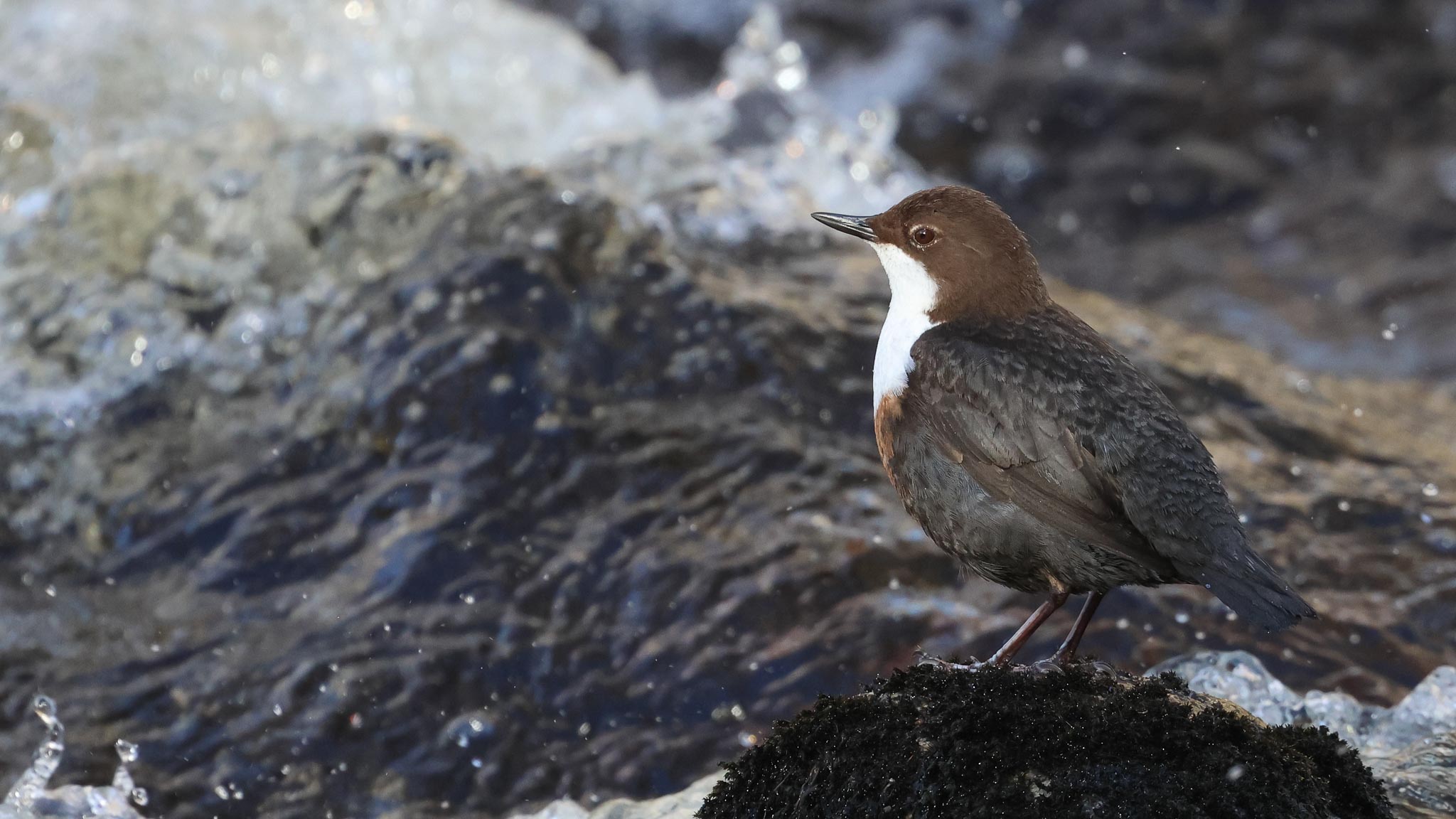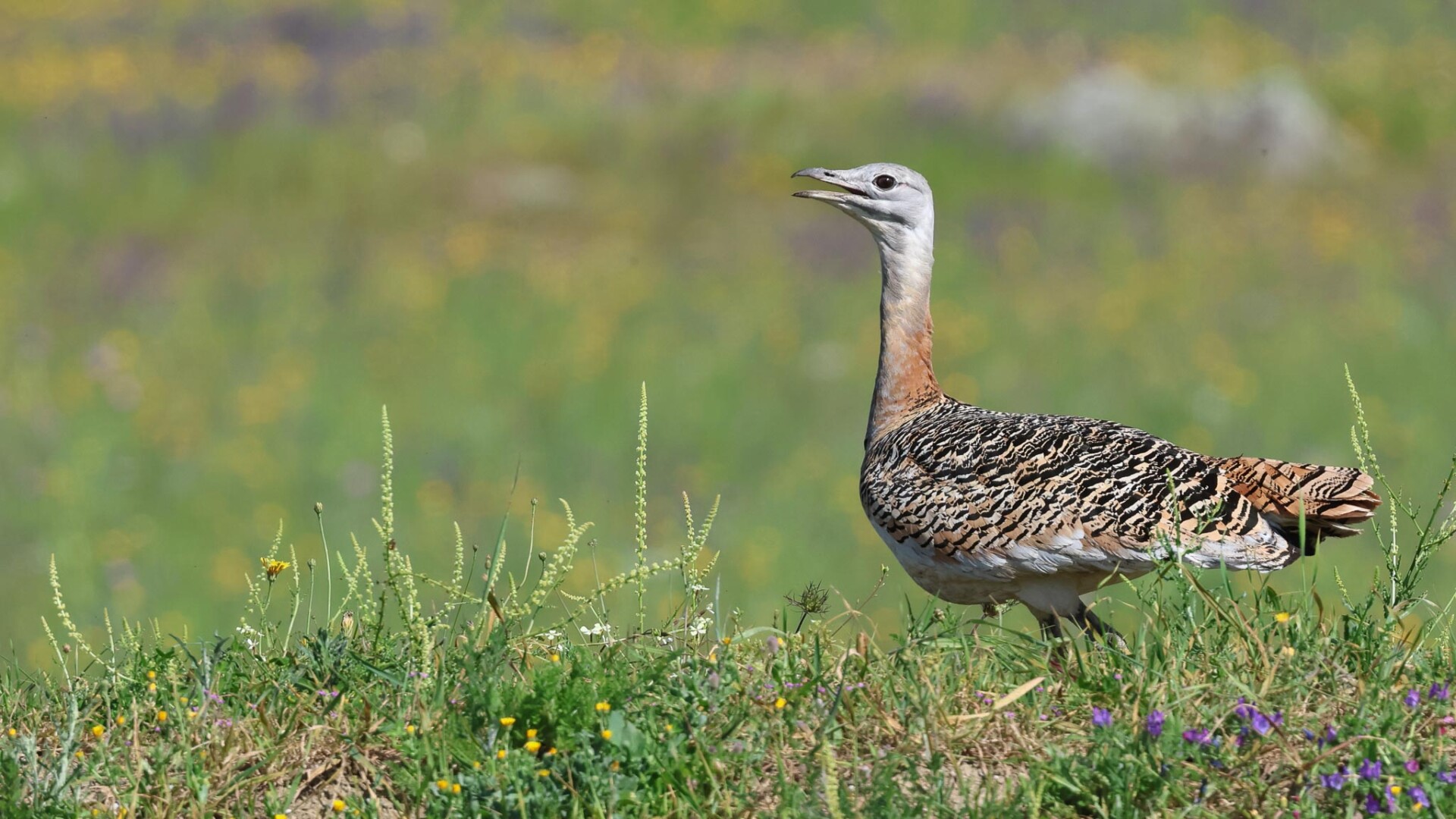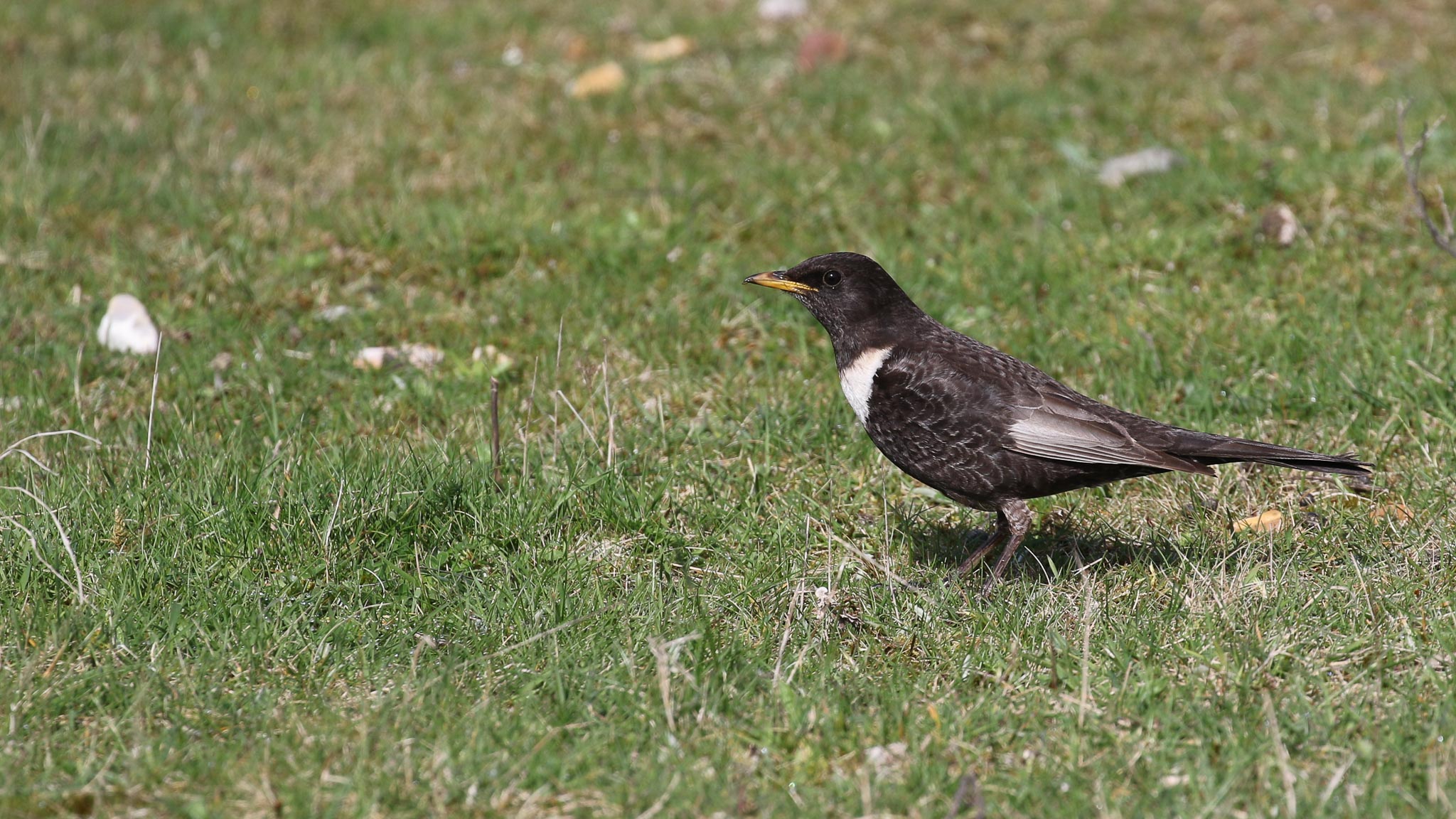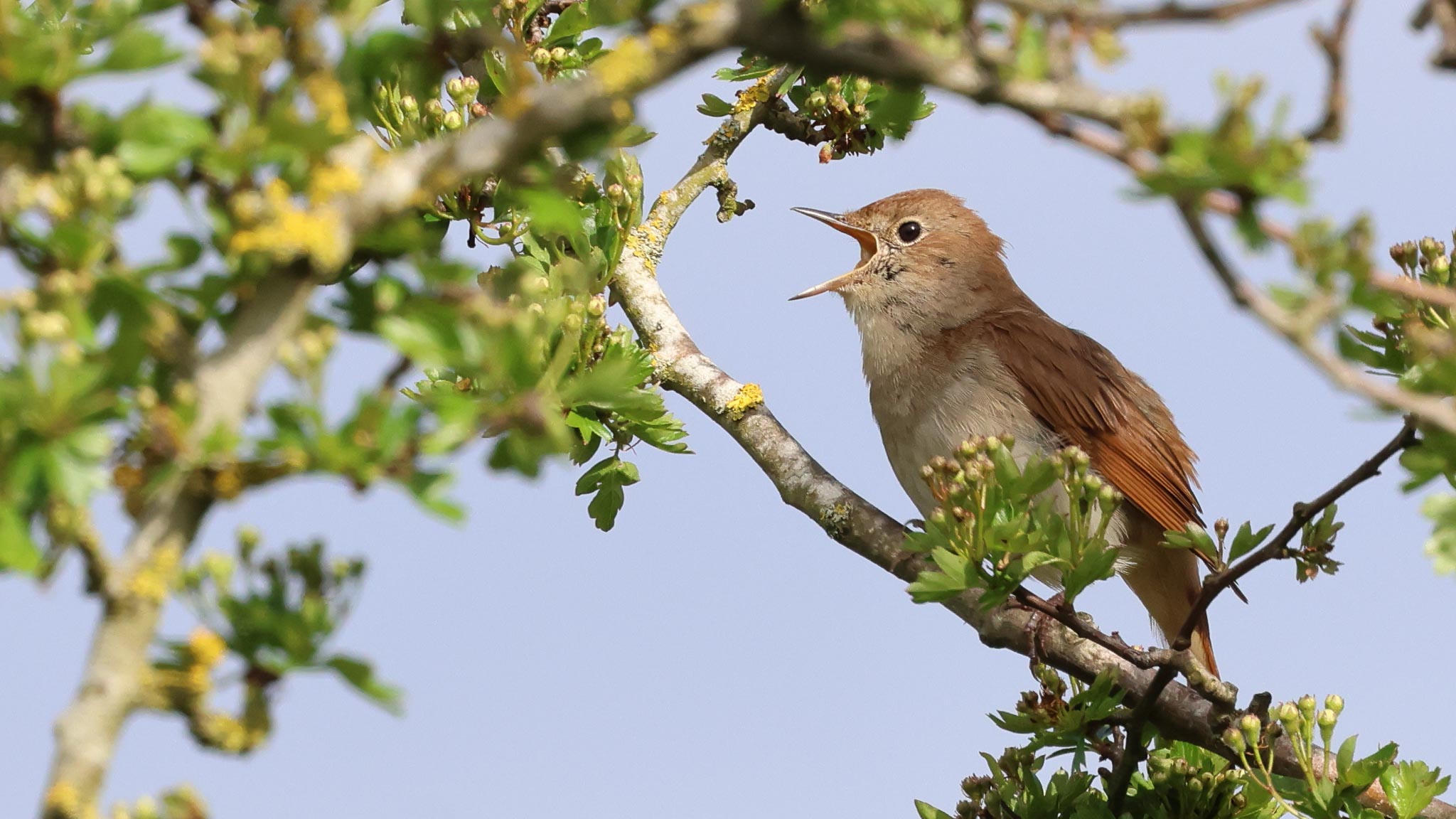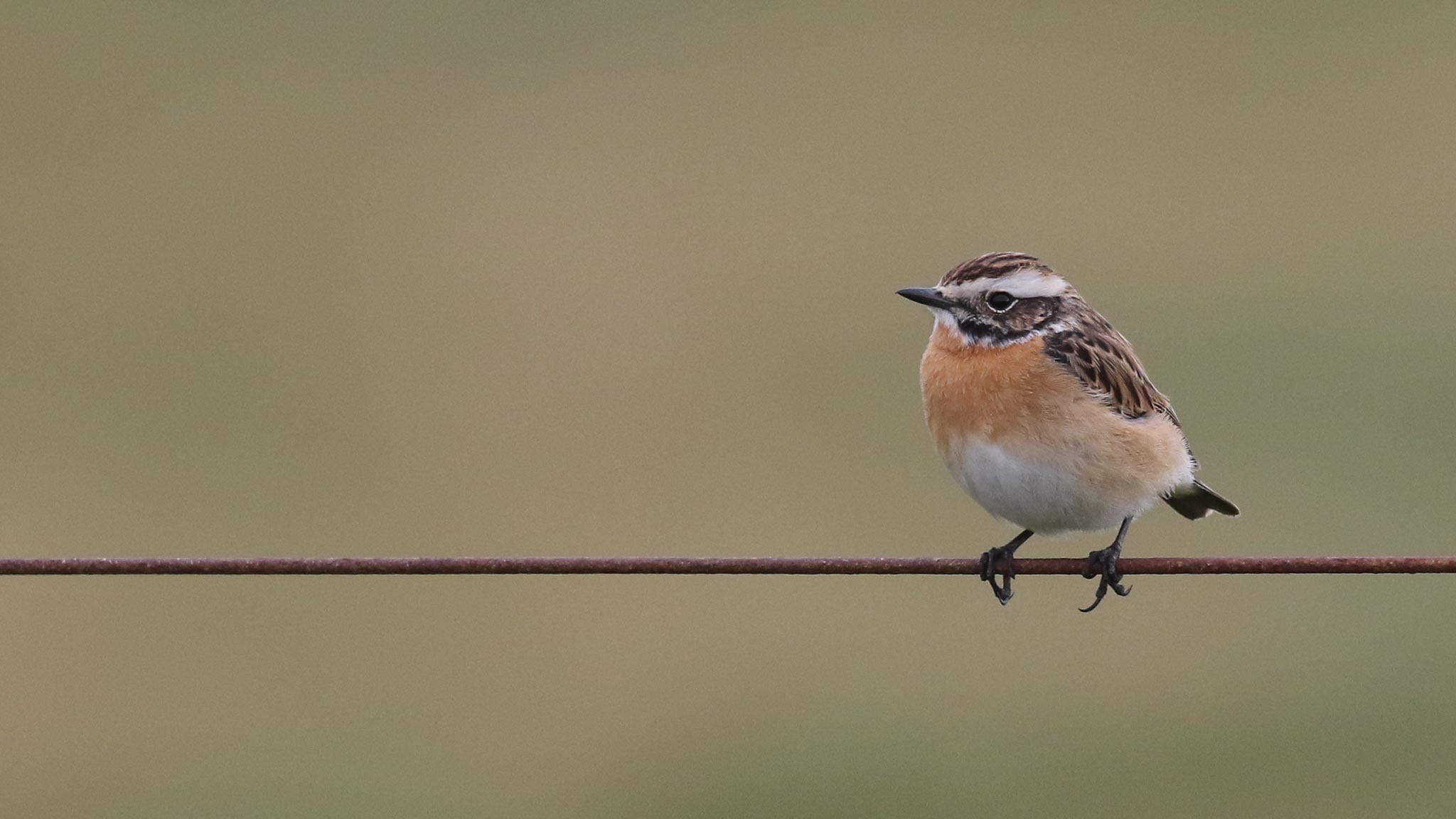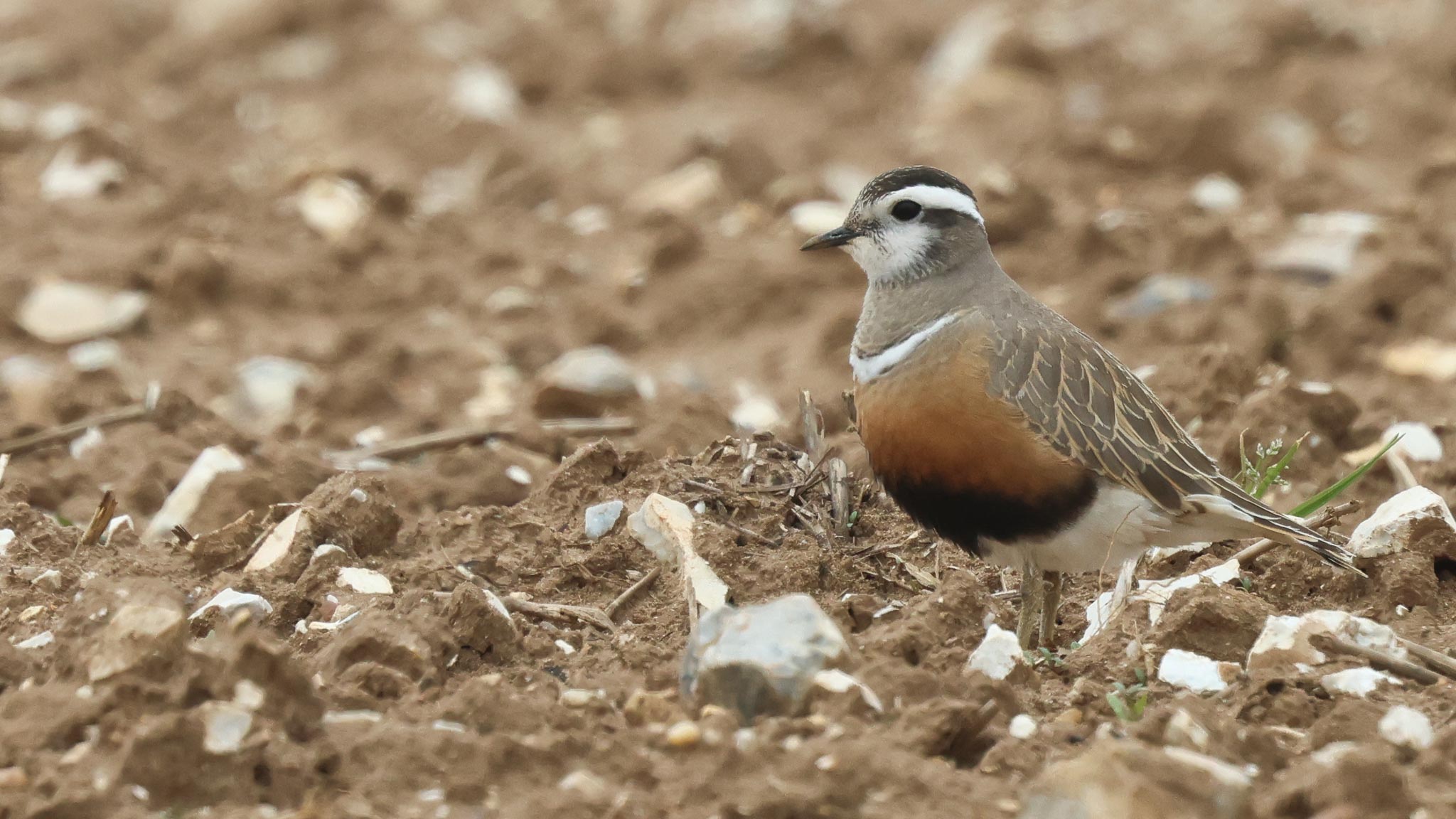Our inaugural Scotland Tour, which had been postponed for the last two years due to Covid, was finally able to go ahead in 2022. We were blessed with glorious weather – lots of blue skies and sunshine and temperatures often into the mid-teens. If you like what you read and are tempted to join us in 2023, we have dates available already for next year so just let us know. Looking forward to it already!
Monday 21st March
Half the group met in Norfolk – we set off from Hindolveston early afternoon and stopped to pick up again in King’s Lynn. It was a typically slow journey west through the Fens, although there were lots of Rooks to watch in the fields by the road, gathering nest material and perched in the trees atop their nests. There were a few Red Kites and Common Buzzards up in the warm sunshine too.
Apart from a brief hold-up due to an accident on the A1, we had a fairly uneventful journey north to Darlington, which was only punctuated by a problem which developed with the diesel particulate filter self-cleaning on the minibus on the last leg. We stopped at the Premier Inn for the night, and made arrangements to pick up a replacement minibus in the morning, then went out to get something to eat in the town centre.
Tuesday 22nd March
We had a very early start this morning, to get up into the Pennines before dawn. As we drove out onto the moors, it was only just starting to get light – there was just the merest hint of a paling in the sky to the east. We pulled up and opened the windows, to be greeted by the most amazing soundscape – against a backdrop of silence, all we could hear were Black Grouse bubbling, Curlews calling and a Common Snipe drumming. Mesmerising!
As it got light enough to see, we trained the scopes on the Black Grouse as they emerged from the gloom. They were all males, puffed up, their lyre-shaped tails spread and their white undertail coverts fluffed out, lekking. We watched as they postured, occasionally facing off against each other, and even one or two fighting. There were 23 male Black Grouse in the main lek, with two more separate males on their own, one still a young male. We could hear Red Grouse calling too, and looked over to see a pair walking round on the hillside a little further over.

A female Black Grouse (a ‘greyhen’) flew down from the hillside behind us and landed down by one of the lone males. The male started to display more actively, but after a few seconds she flew again, across and into the main lek. The males there got very excited, chasing round after her, but she lost interest and flew back to the lone male and then up onto a nearby fencepost. Three more females appeared in the distance, on the slope beyond, and the lone male flew over and started displaying over there instead.
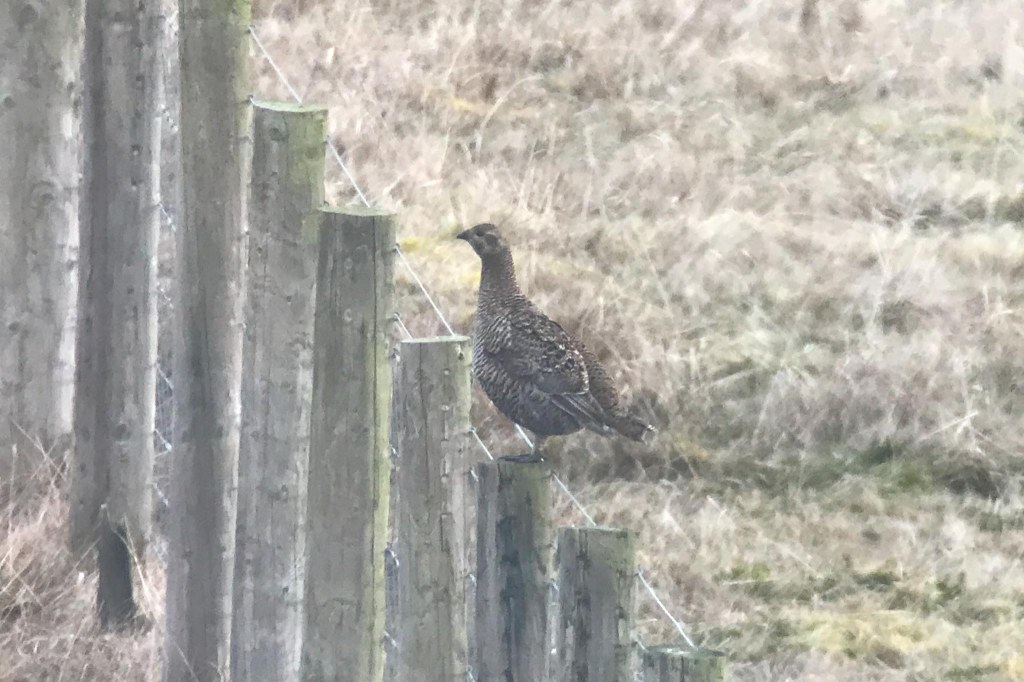
When the Black Grouse in the lek suddenly scattered, flying off in all directions, we looked over to see a male Merlin coming over low. We watched it fly off up the hillside. Hardly a threat to the grouse, but more so to the Skylarks and Meadow Pipits which were singing and song-flighting all around us now, as the sun came up.
It was a wonderful way to spend the morning, watching the comings and going at the lek, but we had a long journey ahead so we decided to move on. As we drove up to the top of the moor, a pair of Golden Plover flew past and a Woodcock flew over over the road and dropped down into the valley below, landing down in the long grass. It came up a couple more times, before it finally settled and disappeared for good.
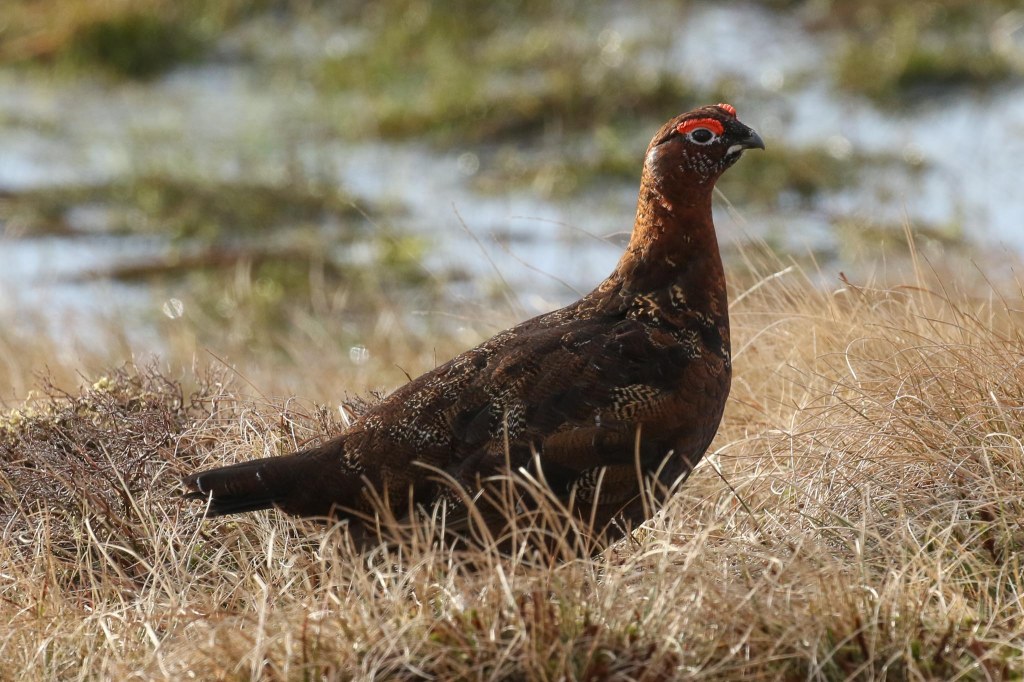
At the top, we stopped to admire some Red Grouse very close to the road and could now see the pair of Golden Plover standing in the heather behind, along with a few more Curlews. Dropping down the other side, there were several Common Snipe standing on various fenceposts by the road in the sunshine.
We dropped back down to Darlington to pick up the replacement minibus, and then continued our journey north, stopping for a late breakfast at Durham Services. We planned to break the journey in Musselburgh and finally arrived there early afternoon, a little later than originally planned.
Two pairs of Goldeneye were in the channel as we walked up towards the Esk Mouth, where quite a few waders were gathered along the shore ahead of the rising tide – large groups of Bar-tailed Godwits and Oystercatchers, along with a few Redshank and one or two Dunlin.
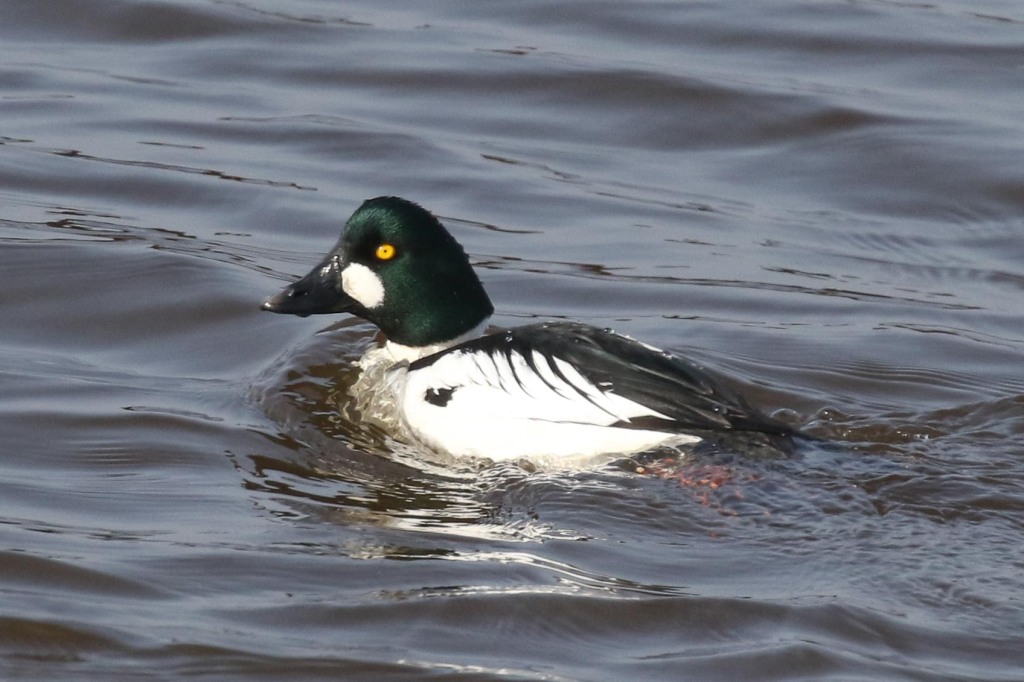
There were lots of ducks out on the sea beyond, rafts of Common Eider and scoter, along with a good number of Long-tailed Ducks. A few Gannets and Kittiwakes passed by offshore and we could see Guillemots and Razorbills too.
Looking through the scoter flocks, there was a nice mix of Common Scoter and Velvet Scoter here, with some smart male Velvets sporting a white spot under the eye and bright yellow edges to the bill. The stunning male Surf Scoter was easy to pick out, with the big white patches on its forehead and the back of its neck and its swollen orange bill, but the female with it was more subtle. We couldn’t find the regular White-winged Scoter with the Velvets off here this afternoon, but it was hazy offshore away to the west, and we could see more scoter off in the distance that way. Unfortunately, we didn’t have time to look from further along the coast this afternoon.
We continued our journey up, and had a smooth run up to Carrbridge, where we settled into our guest house and met up with the rest of the group, just in time for dinner.
Wednesday 23rd March
For those that rose early, we had a quick morning walk along the river before breakfast. There were lots of Greenfinches singing in the village and a pair of Bullfinches flew up into the top of a larch behind the guesthouse. We stopped to admire the old bridge before taking the footpath along the bank. It was a cold and frosty start and we found several Siskins, Mistle Thrushes, and a Song Thrush perched in the tops of the trees here in the sunshine. We heard a Grey Wagtail calling and found a couple of Pied Wagtails in the paddocks. We crossed the river at the footbridge, and stopped to scan but we couldn’t find any sign of a Dipper today.
We walked back along the road. A Great Spotted Woodpecker was drumming and flew out and perched in the sunshine as we passed. We could hear Common Crossbills calling from deeper in the trees and a couple flew out over our heads ‘glipping’. A Treecreeper posed nicely on the birches by the footpath and a distant flock of Pink-footed Geese circled over beyond the village as we walked back to the guesthouse for breakfast.
Given the risk of disturbance to Capercaillie, we would not be going out actively looking for them on this trip and in particular not visiting particular woods early in the morning, despite our visit being outside the traditional sensitive period of April-May when they are lekking. There is still an outside chance of coming across one later in the day, walking on the public paths, when we would be looking for other pine forest species like crossbills and Crested Tits. The birds’ welfare comes first.
So after breakfast, we drove over to an area of forest for a walk. The small pool in the field opposite held a couple of Tufted Duck, Little Grebe, Wigeon and Teal, with Oystercatchers, Lapwings and couple of Redshank in the muddy margins. A pair of Mistle Thrushes were feeding in the field in front and small groups of Meadow Pipits and Linnets flew up onto the fence. Another skein of Pink-footed Geese came over calling.
As we walking in through the trees along the main ride, we could hear a crossbill singing ahead of us and as we got closer two birds flew across the track calling. The flight call sounded Parrot/Scottish type and we could see the birds looked heavy-billed. One was now singing in the trees across the path and we managed to find an angle where we could get it in the scope. Its bill looked intermediate in depth, thicker than a Common Crossbill but not as bulky as the Parrot Crossbills we occasionally see in Norfolk during periodic irruptions from the continent, more consistent with what we would expect on ‘Scottish Crossbill‘.
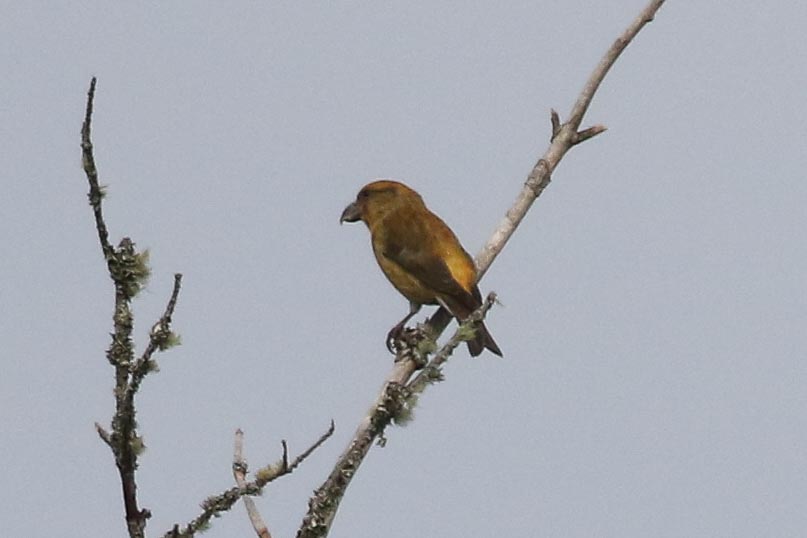
The crossbill dropped from view but we could still hear it singing. After a minute or so it flew back across the track where it landed in the top of a pine right next to the path. We were looking into the sun here, but we could still appreciate the size and structure of its bill and even though it remained rather mobile we had a good chance to study it from various angles.
Historically, the only accepted method for conclusively identifying Scottish Crossbill was to record a so-called Type C excitement call, but even this has recently been shown to be unreliable. Just this month, the Scottish Rare Birds Committee has announced that it has stopped considering records of Scottish Crossbill until any alternative identifying characteristic can be proven. So there is no way we can conclusively identify these crossbills either! ‘Scottish Crossbill‘ remains our best guess, but regardless of species they remain fascinating birds and it was great to watch and listen.
Continuing on round on the path, it was rather quiet in the trees. A Comma butterfly fluttered up from the side of the track in the sunshine. As we made our way back towards where we had parked, we heard a Crested Tit calling ahead of us, but by the time we got up to where it had been it had gone quiet. When the Crested Tit called again it was much deeper in the trees and we couldn’t see it.
We moved on and drove over towards Dorback next. A Red Squirrel ran across the road and up into a tree beside the minibus. A bit further along, we stopped for coffee in the sunshine. A couple of Common Buzzards circled up and a Merlin drifted over. Scanning the hills, we picked up a distant Golden Eagle which we watched in the scopes as it circled up, our first of the trip.
After a quick stop in Nethy Bridge to use the facilities, we drove on to Loch Garten. The visitor centre was still closed for refubishment, but the car park was open and full of toads! We stopped for lunch down by the loch and afterwards, walked down to Loch Mallachie. There were lots of finches in the pines, Siskins and Chaffinches, and stopping to look through them we found lots of smart Bramblings too. There were plenty of Coal Tits here too, but no sign of any Crested Tits today.
Down by the Loch, there were lots more toads, some mating in the middle of the path, and we had to watch where we were walking! There were a few ducks and geese over at the back – Wigeon, Mallard, Greylags and a single Goldeneye. Back through the trees on the other side of the loop, it was a bit more exposed to the wind, and quieter but along the path back to the Loch Garten car park we did come across a Goldcrest and a Treecreeper.
Back in Nethy Bridge, we went to see if we could find the Waxwings. They had been around since early February and were seen late yesterday afternoon, but we couldn’t find them today – it later became clear they had obviously departed overnight and were not seen again. We did see some nice Bramblings around a garden with some feeders, although a Goldfinch asleep on one of the perches didn’t look well. A close Goldcrest was flitting around in the hedge.
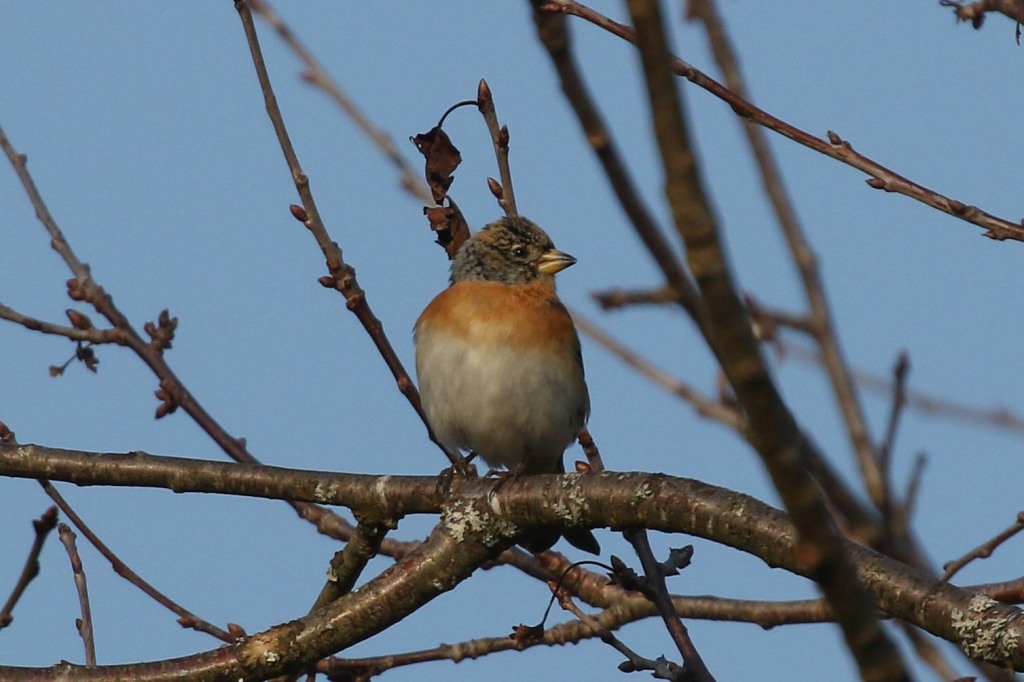
On our way back to the minibus, we stopped to scan the river. One of the group spotted a Dipper over by the far bank, but before everyone could get onto it, it flew and we lost sight of it behind some trees. We thought it probably hadn’t gone very far, but despite walking down along the footpath to the next bridge, there was no further sign.
We drove back via Broomhill bridge and stopped for a quick scan of the river. Several Goldeneye were down on the water and a lone Pink-footed Goose flew over calling, and dropped down towards the fields behind the trees. From the other side of the bridge, we found over a thousand Pink-footed Geese feeding in the fields. Then it was time to head back for dinner.
Thursday 24th March
We took a short drive out of Carrbridge for our (optional!) walk before breakfast this morning. At the end of the road, we got out to scan the fields. There were just a few Greylag Geese out on the grass here this morning, so we walked on down the path towards the river. A couple of Song Thrushes flushed out of the grass ahead of us and a Mistle Thrush was feeding along the fence line. There were lots of Common Gulls and a few Oystercatchers down by the water. It was not forecast to rain this morning, but we could see low clouds over the hills beyond and it started to drizzle so we walked back to the minibus to shelter.
On our way back to the minibus, a couple of Redpolls flew over calling and now we realised there were more in the trees behind the bus. As the shower eased, we walked up the slope to look in the trees. There were lots of finches in here, feeding on the cones – Siskins and Goldfinches, as well as the Redpolls. They mostly looked like Lesser Redpolls, but one looked to have paler tramlines and a paler ground colour to the rump. Unfortunately they would not stay still long enough for closer examination.
A flock of Common Crossbills flew over the hillside beyond and landed in a group of pines up on the top. By the time we had run back down to the minibus and grabbed the scope, the Crossbills had dropped down out of view but we didn’t have to wait too long before one or two came back up into the tops, included a typically small-billed, bright red male. Then we had to hurry back for breakfast – no time to stop to admire the Red Deer on the edge of the trees.
After breakfast, we had a quick walk in the woods nearby. More crossbills flew over the trees calling and a Jay flew across the path in front of us. We were still hoping to catch up with a Crested Tit, but once again all we found were lots of Coal Tits. As we got back to the minibus, a Goldcrest was singing nearby and a Treecreeper was climbing up the trunks of the trees.
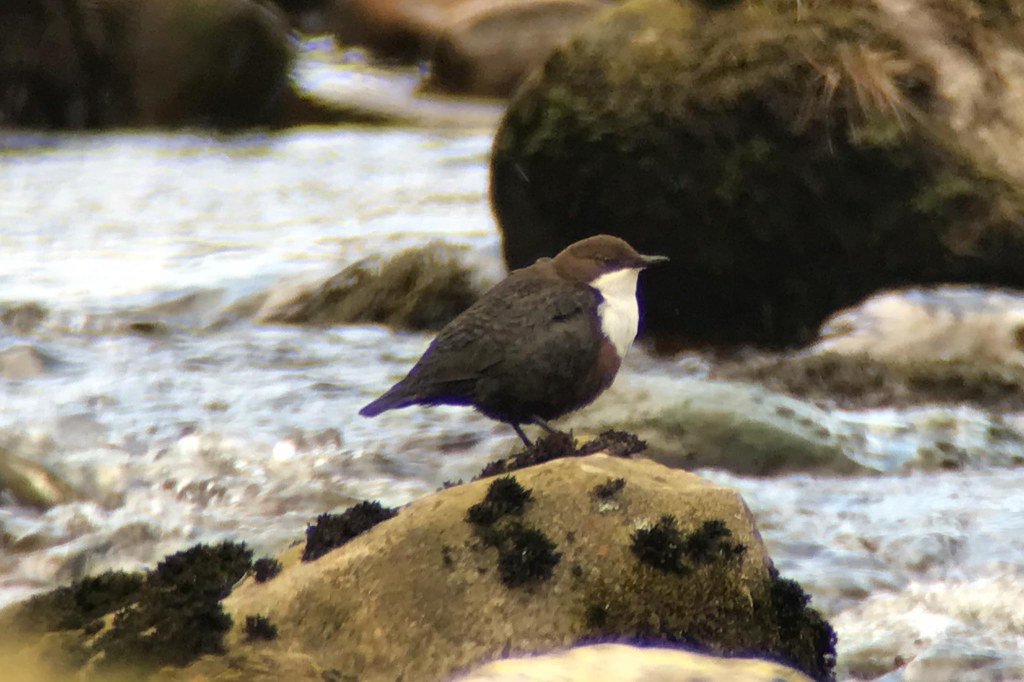
Our destination for the morning was the Findhorn Valley. We stopped a couple of times to scan the river on the drive up and the second stop we found a Dipper on a little stream under a bridge. It flew out to the river and landed on a large rock before dropping down into the water, then flew in towards the bank below us. We parked a little further up and walked back. There was no further sign of the Dipper at first, then we heard it flying down stream along the river towards us calling, and looked over to see two chasing after each other. They had obviously flown off further downstream, but eventually one flew back in from the river calling and landed on a rock in the stream, where we had a great view of it.
The sun was shining and it was warming up nicely now here, where we were out of the wind. Scanning the hilltops, there were several Common Buzzards circling up, plus a Red Kite, and our first Ravens. We continued on up to the top of the valley where we stopped for coffee. There were a few clouds now, and it was a bit breezy here, so it felt decidedly cooler. A Raven tumbled over the tops, and a couple of Common Buzzards were hanging over the tops. A Meadow Pipit was singing and displaying behind us.
We were going to move on, but we could see the sky clearing again so hung on a little longer. As the blue sky reappeared, a Peregrine appeared right overhead from behind us, drifting down the valley before stopping to tussle with a Buzzard, which responded by stooping sharply down to the hillside out of harm’s way.

The warmth also brought out a Golden Eagle, over the top of the hillside lower down the valley. As we watched, it dropped down in front of the face and flew across until it was lost from view. We thought it might be worth another look lower down, so we packed up, and drove down. We stopped and scanned, but at first there was no further sign of it where it had gone down.
Then the same or another Golden Eagle appeared over the tops back where we had first seen it. We got it in the scopes and watched it circling up. It was joined by a Buzzard, which looked tiny by comparison, and when another raptor circled up from below we realised it was a ringtail Hen Harrier. Amazing what a bit of warmth will do for raptor activity!
We drove further down, back to where we had earlier seen the Dipper, and stopped for lunch by the river. There was no sign of the Dipper now, but a Grey Wagtail was singing from the rocks along the stream. It was a lovely spot to sit and eat in the sunshine.
After lunch, we drove up over the Farr Road. As we got out onto the moorland at the top, we could see another Golden Eagle circling over the road ahead of us. By the time we had got up to there, it was drifting away over the valley but after a quick dismount we had great views of it circling against the hillside beyond, this one an immature with bold white patches in the base of the primaries and the tail.
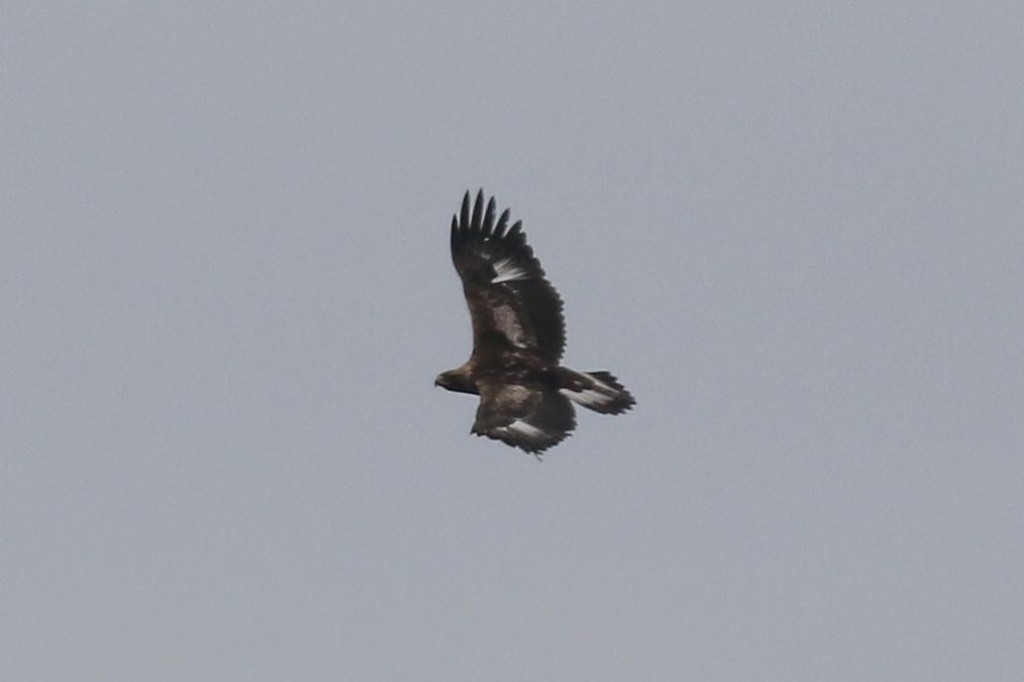
It drifted down the valley and back across towards where the road was much further down, so we decided to give chase. We caught up with it and stopped again, everyone getting out very quickly this time – after a bit of practice! The Golden Eagle was circling in front of us, then it was attacked from above by a Buzzard. Eventually it drifted away to the crags beyond, with the Buzzard still in pursuit.
We continued on down the valley and then round to Loch Ruthven. A Reed Bunting came up from the side of the road and a male Stonechat was perched in the top of the trees opposite the car park. A couple more Red Kites were circling over the hillside beyond.
Walking down the path to the Loch, the first thing we found was a Little Grebe. Then scanning more carefully we found our target here, a pair of Slavonian Grebes. They were right at the back, and rather distant views even through the scopes, but we could see they were in breeding plumage. Another one appeared nearby, not yet fully moulted and still looking more patchy. There were several Goldeneye out on the lock too.
Continuing on down to the hide, a Treecreeper was singing in the trees and once again we had to tread carefully to avoid all the toads on the path. The pair of Slavonian Grebes had come much closer now, and the light was better from here so we had a much better view of them now. We could see their bright golden yellow head tufts. Very smart and very different from the black and white winter birds with which we are more familiar.
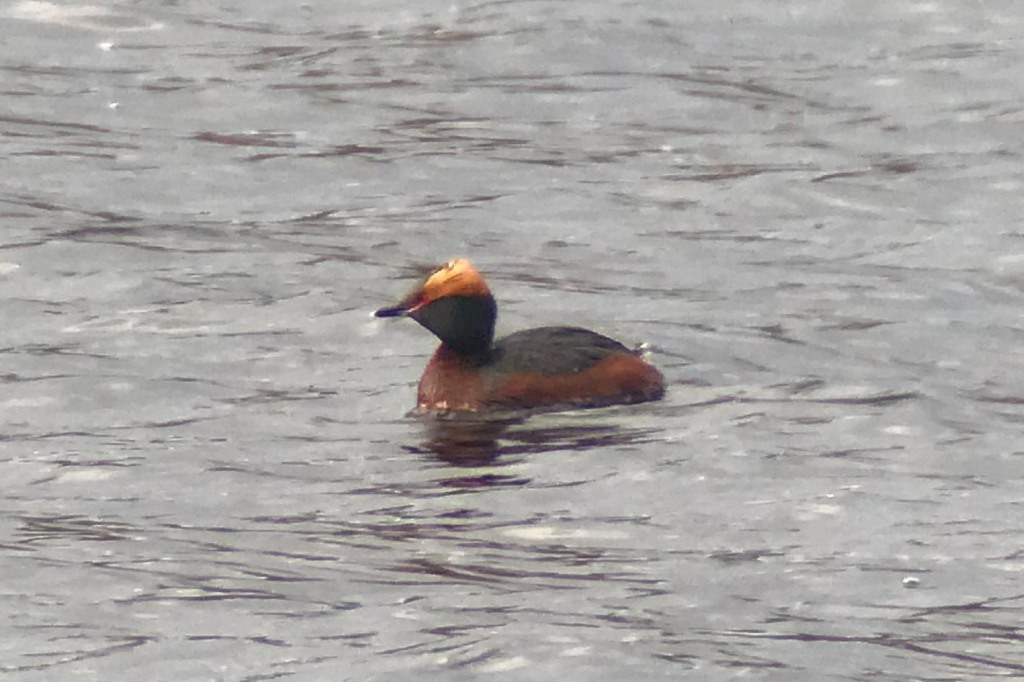
We still had a little bit of time to play with, so we drove quickly back to Aviemore and up to Cairngorm base station. We had been told that the first Ring Ouzels had arrived back yesterday and figured if we could find one this afternoon, it would give us a bit more time tomorrow. But we could only have a quick search now, before we had to be back, so we needed a bit of luck. We walked all round, beyond the buildings where they had been yesterday, but we couldn’t find it so we thought we were out of luck.
Half of the group were already in the minibus, and we were just waiting for the last person to walk back, when we heard something behind us and looked round to see a male Ring Ouzel on a small pine tree on the far side of the car park. One of the group didn’t believe the shout at first until someone else announced ‘this is not a drill!’ and quickly everyone piled out again. Just in time – we had a good look at it, then had to head back quickly to Carrbridge where we were very nearly late for dinner.
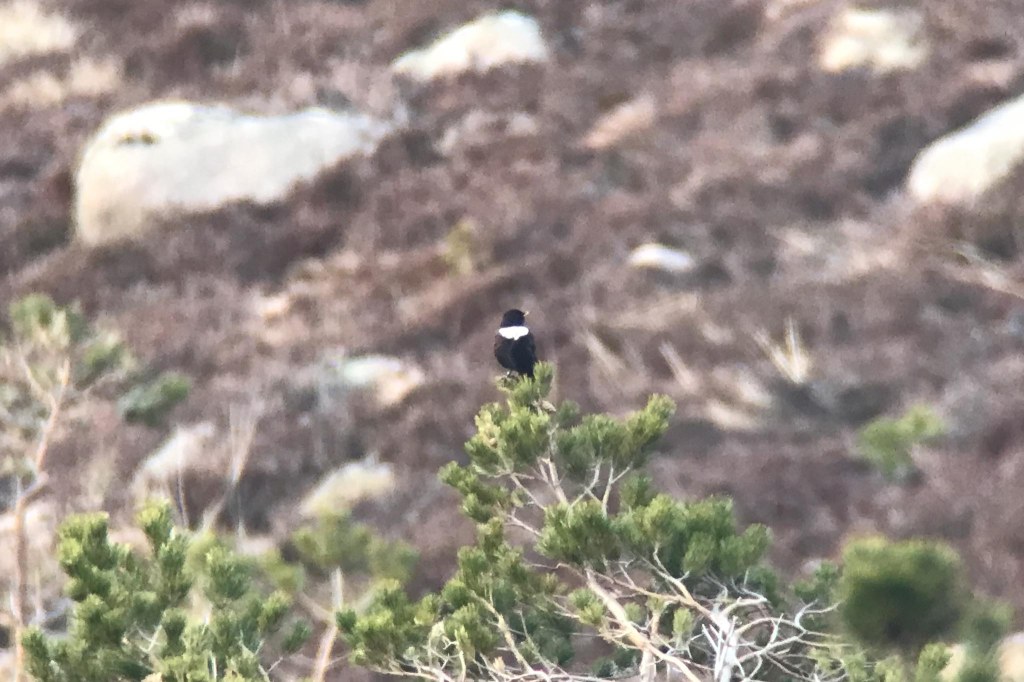
Friday 25th March
We wanted an early walk in the woods this morning, as we still hadn’t caught up with Crested Tit, but we couldn’t go in some of the local woods for fear of causing disturbance, so we had a quick drive back down to Loch Mallachie as we knew they had been seen here recently. It was meant to be sunny today, but it was a cloudy and cool start and slightly misty around the lochs. It made for a lovely view across Loch Garten from the trees.
It was perhaps a bit too early for birds though and it was quiet in the trees at first. A Crossbill flew over calling and there were the ubiquitous Siskins and Chaffinches up in the tops of the pines still. A pair of Goldeneye were at the back of Loch Mallachie now. It was only as we walked back to the minibus that the morning sun started to penetrate the clouds, and suddenly the tits were more active. We stopped briefly to watch the Coal Tits, Great Tits and Goldcrests in the trees by the car park, and then we had to head back for breakfast.
We were heading up to the Moray Coast today, but we decided to call in for a quick look at Lochindorb on the way north. On the way, we noticed a Golden Eagle circling over the hillside across valley and it turned and started to glide over our way. We managed to stop the minibus ahead of it and got out (we had lots of practice at rapid exits from the minibus by now – once again, it was not a drill!) and we had great views as it drifted right over us. An immature, clearly older than the one we had seen yesterday with much smaller white patches in the primaries. We were doing well for eagles on this trip, but were still not ready for what was yet to come.
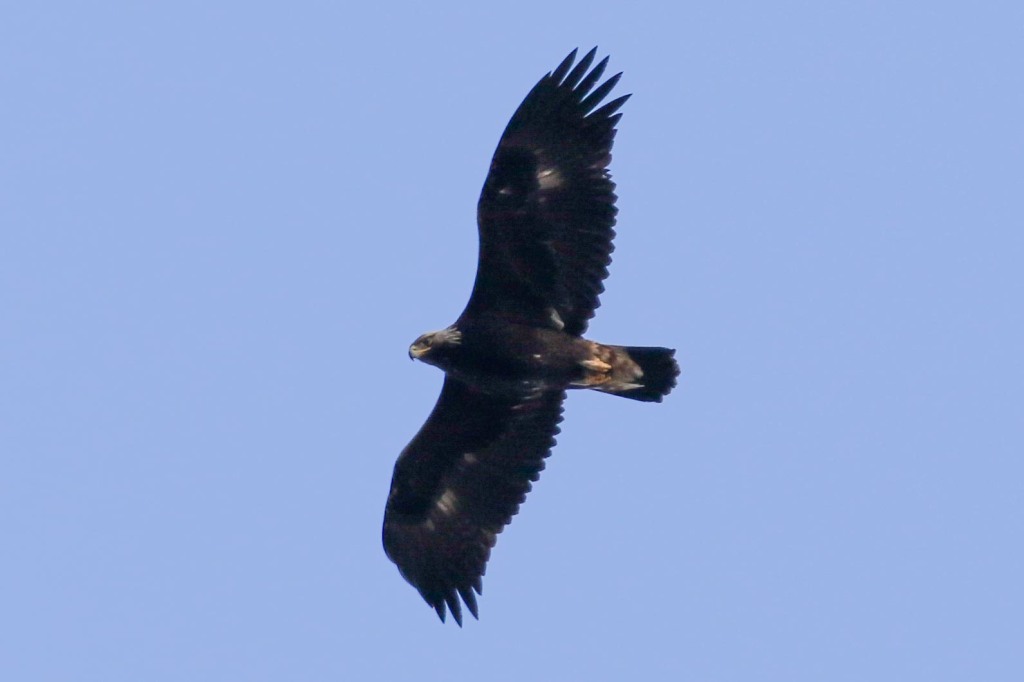
Along the minor road down to Lochindorb, one of the group spotted the head of a Red Grouse in the heather close by. We pulled up as those of the group who hadn’t journeyed up in the minibus still hadn’t seen one, but it was not obvious and well camouflaged until you realised where it was hiding.
We stopped further up to scan the loch, but a paddleboarder out on the water probably didn’t help. We noticed a Red Kite over the moors at the far end and when one of the group asked “what’s that raptor”, we assumed at first they meant the Kite. But when we looked across the water, we noticed it was actually a young White-tailed Eagle circling over the hillside beyond. We got the scopes onto it, and two juvenile Golden Eagles appeared with it, followed by another White-tailed Eagle, all circling together and chasing each other round over the hillside! A distant diver flew through the same view, but it was high and flying away from us, and we were slightly distracted. As if that wasn’t already being greedy, as the eagles drifted away yet another White-tailed Eagle joined them – five eagles together in the same scope view!
Our first destination on the coast was Cullen. There had been some White-billed Divers here earlier in the week and we hoped one or two may still be lingering. It was beautifully sunny when we got out onto the clifftop, and we set up the scopes to scan the sea. The gorse in front of us was in flower, and a lovely male Yellowhammer appeared in the yellow flowers. A couple of Linnets flew over.
There were lots of birds on the sea – rafts of Eider and Long-tailed Duck. A selection of auks, with lots of Razorbill and Guillemot and we eventually managed to pin down a couple of Black Guillemot out on the sea too. There were a few Gannets and Kittiwakes passing offshore and Fulmars coming into the cliffs further along. We managed three diver species off here – three Red-throated Divers close in, a single Black-throated Diver and a single Great Northern Diver, but no sign of any White-billed.
It was a lovely spot here in the sunshine, so we got the lunch and coffee stuff from the minibus and stopped here to eat on the grass overlooking the sea. Perfect! After lunch we had another scan of the sea, but the birds were much the same as we had seen earlier. From the other side of the gorse, looking down at the harbour, we could see just how many Long-tailed Ducks were off here today – we counted at least 300, but they were flying round and there were quite possibly a lot more. Impressive stuff, particularly with so many adult drakes amongst them.
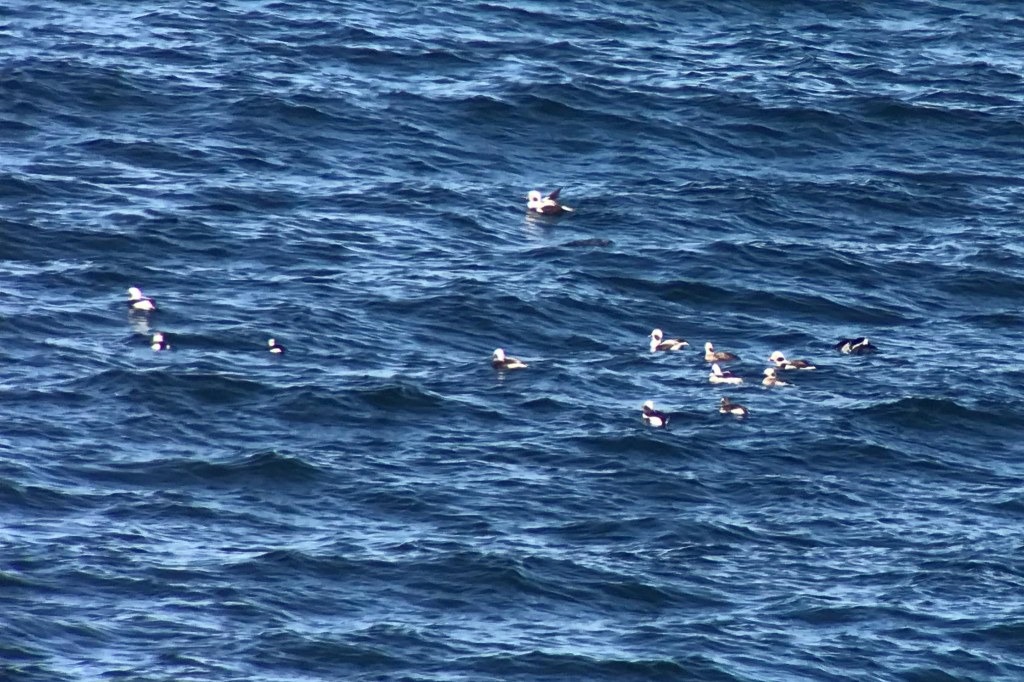
We made our way back west along the coast road next and turned off just before Elgin, pulling up in a layby overlooking Loch Oire. There had been a drake Ring-necked Duck here a few days ago but it hadn’t been reported recently. Still, as we were passing we thought we would take a luck. There was no sign of it at first – quite a few Tufted Ducks, a few Wigeon and Teal, a handful of Goldeneye. A Chiffchaff was singing from the trees in the sunshine – a new bird for the trip list.
We thought we might be out of luck, but then the Ring-necked Duck appeared from behind the island at the far end. We just got the scope on it but it disappeared back in before everyone could get a luck. We walked down the road, but the trees were too thick further along to see round behind the island. Thankfully, as we walked back to the layby the Ring-necked Duck appeared again and swam round to the front of the island. This time we got a much better look at it – a really smart bird and always instructive to see it next to the drake Tufted Ducks for comparison, with its much more striking bill pattern, peaked back of the head and two-toned flanks.
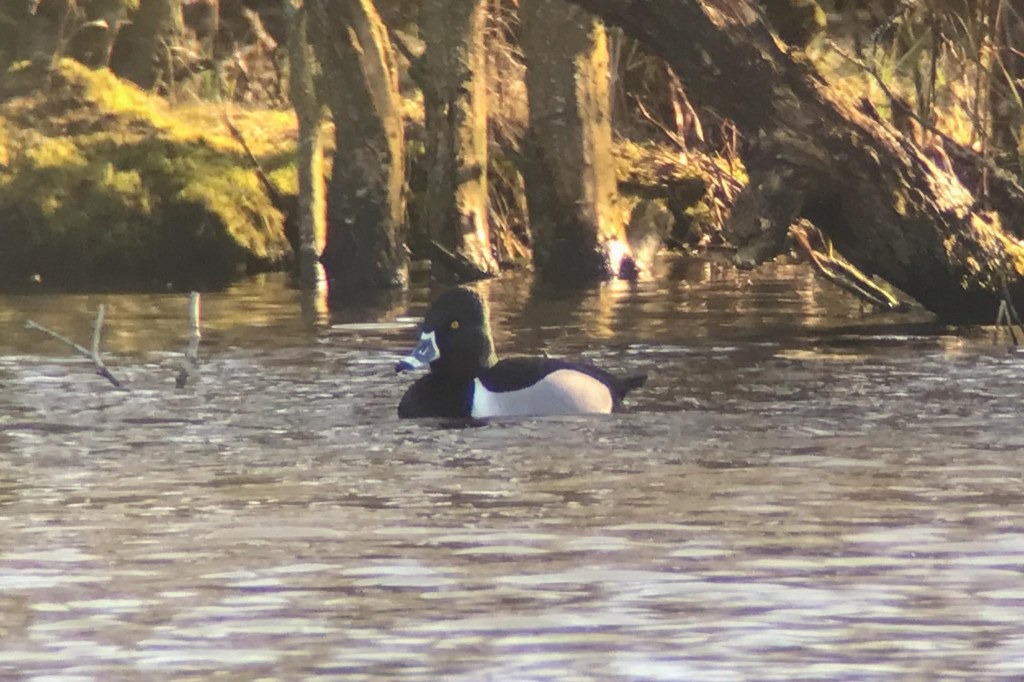
Ring-necked Duck – a very smart drake
After a quick stop at Tesco in Elgin to refuel, we continued on to our last stop at Roseisle. We only had about an hour here, but it was a lovely place to stop. We stood on the top of the dunes on the edge of the trees, looking out across Burghead Bay in the late afternoon sunshine. There were some nice scoter off here, although the heat shimmer on the water made it a little difficult to pick out much at any distance. We did get some nice views of both Common Scoter and Velvet Scoter though, including a nice drake Velvet showing off the yellow on its bill and white crescent under its eye.
Then it was time to head back. We still had one last bonus to end the day though. As we drove into Carrbridge, a pair of Goosander were on the river right below the bridge so we stopped and got out for a look. We thought they might spook, so approached very carefully, but instead they just swam about on the river below us.
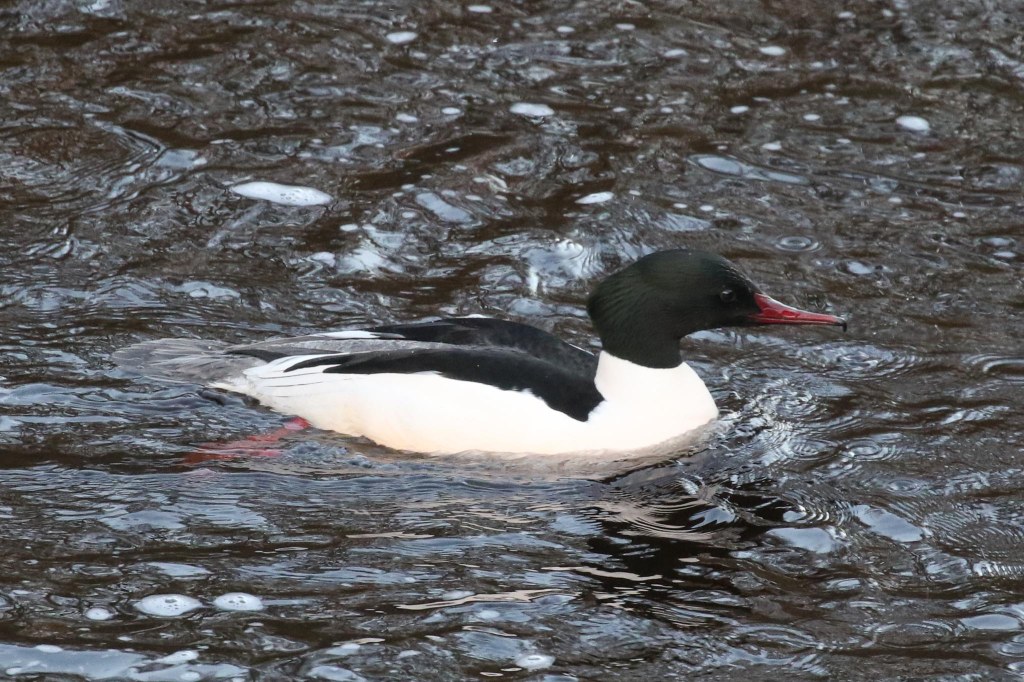
Saturday 26th March
Before breakfast this morning, we had a quick drive out to see if we could find some Black Grouse for those members of the group who had not travelled up with us. It was a bit misty this morning, but we could hear the bubbling of the Black Grouse as we pulled up and we could make out some black shapes out on the grass. It was rather atmospheric in the mist!
When the fog rolled in and we couldn’t even see the black shapes any more, we decided to try something else. We drove back round towards Lochindorb, and back out into the sunshine. At least three Red Squirrels were along the side of the road on the way down to the loch and scurried up into the trees as we passed. Further along, there were a pair of Oystercatchers and a pair of Redshanks along the shore, but there were two cars and people camping here now.
As we made our way back, we swung round via the Black Grouse again and the mist/fog had cleared now to beautiful sunshine. The light was perfect and we counted at least 10 males out on the grass, with some stunning views through the scope viewed from a distance. Then it was back to Carrbridge for breakfast.
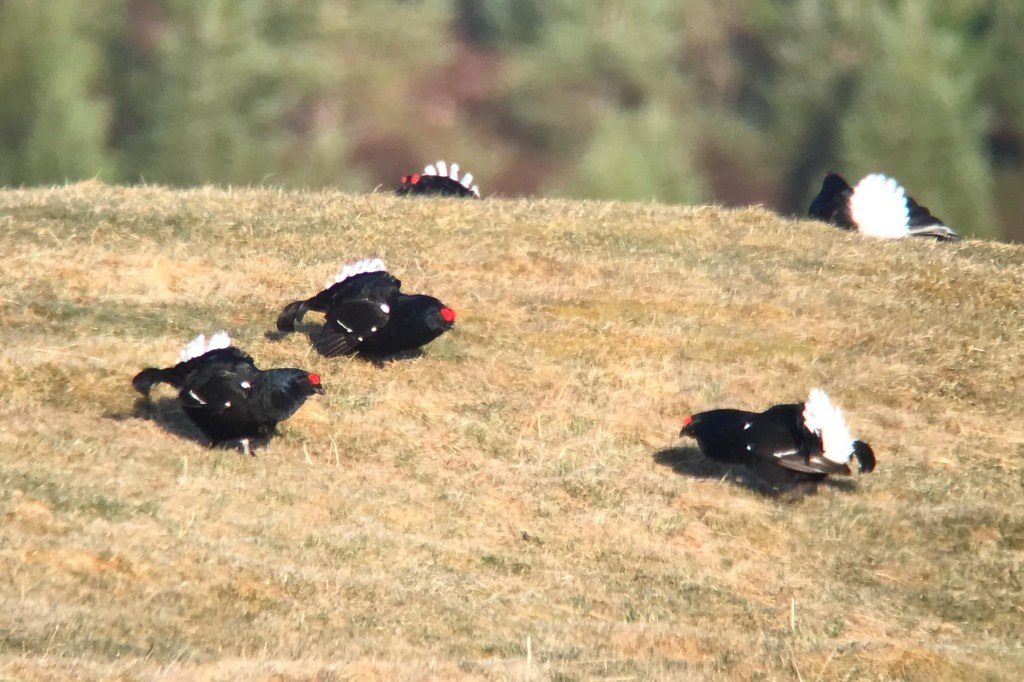
After breakfast, we headed out west. Past Inverness, a couple of Red Kites hung over the road and one of the group spotted a diver on a loch but we had cars behind and nowhere to turn round. We figured we would have another look on the way back. We had a quick stop at Lochcarron and while everyone was waiting to use the facilities, we got a scope out and scanned the water. There were lots of Red-breasted Mergansers out on the loch, including two pairs displaying, the drakes with their spiky punk crests raised and throwing their heads back. Twelve Whooper Swans at the far end were presumably stopping off on their way north. There were two or three Common Seals on the rocks in the middle too.
We took the minor road towards Applecross and there were lots of Red Deer on the hillside as we wound our way up towards the pass. It was a bit cloudy up at the car park at the top, so we donned coats and appropriate clothing as we set off to walk to the weather station. Two distant Golden Eagles drifted over the hillside beyond.
By the time we got to the top, the clouds had cleared and it was glorious sunshine again. Scanning all around we picked up a distant adult White-tailed Eagle circling over the hills. It didn’t help that it was warm and sunny now, and it was already midday after the long drive over, and other than the eagles it was rather quiet bird-wise up here. Half the group walked all round the top, but the only thing we could find was a Mountain Hare which ran out from behind some boulders.

When we got back to where we had left the rest of the group enjoying the stunning views over the surrounding hills, they had heard a Ptarmigan calling. Unfortunately they thought the sound had come from down the sheer face in front. We tried searching the boulder field nearby, but there was nothing there now besides a lone Raven and, rather more surprising up here, a Woodcock which flushed a pile of rocks. Another distant Golden Eagle circled up in the distance.
We had run out of time and had to head back down for a late lunch. While we ate back in the car park, another White-tailed Eagle, a young bird this time, circled overhead. A Raven flew in and landed on the rocks in front. Perhaps both having smelt our delicious tuna mayonnaise sandwiches?
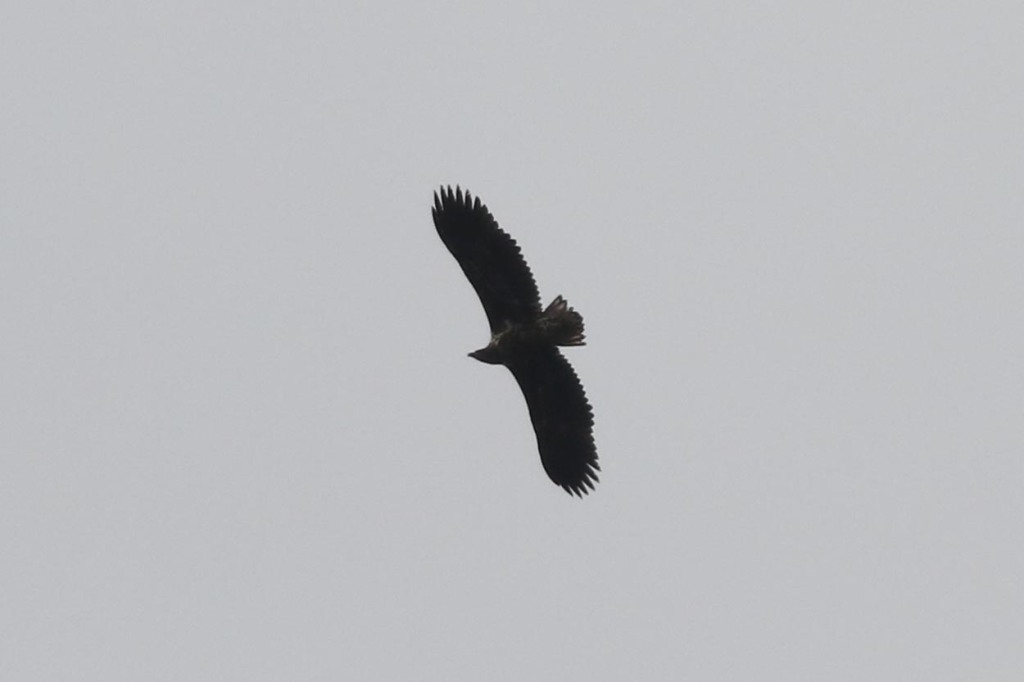
After lunch, we dropped down over the pass to the village of Applecross and stopped to use the facilities. Again, we got the scopes out for a scan while we waited. A single Common Scoter was just offshore with a small raft of Eider. There were more Red-breasted Mergansers here including a flock of nine displaying over by the far shore. At least six Great Northern Divers were mostly still in non-breeding plumage, but one already had acquired the black and white chequerboard back. There was a single summer plumage Red-throated Diver too and five fantastic Slavonian Grebes, again mostly in breeding plumage already.
There were two Hooded Crows on the beach when we arrived and first one then the other came in to bathe in a stream flowing down the beach right in front of us. A Rock Pipit was feeding in the rocks down on the shore and a second dropping in higher up the beach in front of us. What a productive stop, again with a stunning view and bathed in glorious sunshine. Not typical conditions for the west coast at this time of year!
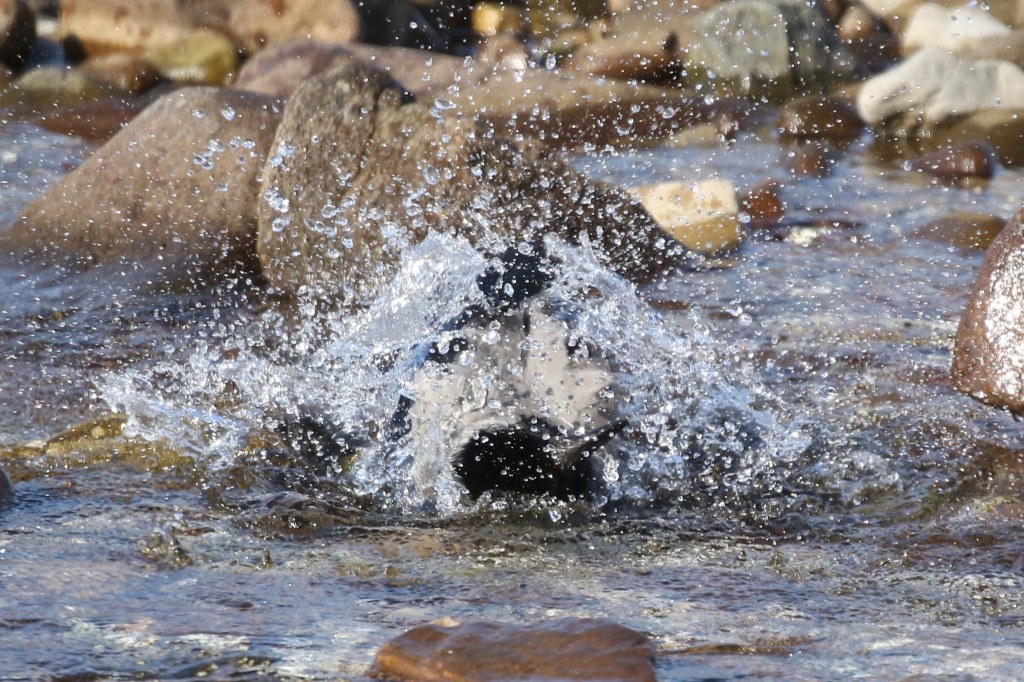
We carried on the long way around the coast from here, again taking in the fantastic scenery, the stunning views out to Skye and then across to the Outer Hebrides beyond. Another quick stop revealed more Great Northern Divers offshore, at least 15 here feeding in the Inner Sound. Several Stonechats perched on the fences and there were more Hooded Crows.
We stopped again looking out over Loch Torridon and it appeared to be rather quiet here at first, although we were quite high up and a long way from the water. Scanning with the scope, we did find two more Great Northern Divers, several Red-throated Divers, three Slavonian Grebes, a raft of Eider and a couple of Wigeon right over the far side.
Another impromptu stop further on to scan an enticing looking Loch by the road produced just what we had hoped it might – a stunning summer plumage Black-throated Diver out in the middle, of which we enjoyed some lovely views through the scopes. Three redhead Goosander flew up from the edge of another loch further on, and a Red Deer was grazing right by the road, oblivious to the tourists stopped to photograph it. As we were passing, we diverted the short distance back to the loch where one of the group had seen the diver earlier, but there was no sign of it now. However, a Greenshank in the shallows here was a nice bonus for our efforts.
It was a great trip round admiring the amazing west coast scenery, but now we had the long drive back to Carrbridge and we phoned ahead to confirm the arrangements for a slightly later than normal dinner.
Sunday 27th March
The clocks had gone forward overnight, and as we were leaving today too, there was no time for an early walk before breakfast. A couple of the group had taken an early flight back, as they wanted to get home for Mother’s Day, but the rest of us packed up after breakfast and headed into the forest for one last walk, still hoping for a Crested Tit.
The track to Forest Lodge is now gated, and although the sign is rather mealy-mouthed and woolly in its wording, we assume it means we now have to walk in. We hadn’t gone far when we heard Bramblings singing and when we stopped to look, picked up a couple of crossbills in the top of the pines. We got them in the scope, but just at that moment a car came the other way down the track, and we had to move out of the way. Even worse, the driver decided to stop to ask us what we were looking at. By the time they drove on, we had only just got the scope back on the crossbills when they flew off. They didn’t call but again looked rather intermediate-billed, presumably more Scottish Crossbills?
Continuing on, there were lots of Siskins in the trees again, plenty of Coal Tits and a Treecreeper, but nothing else of note. By the time we got to Forest Lodge, we didn’t have a lot of time left to explore the trails today. We took a short walk down one of the tracks but it was warm and sunny now and very quiet here so we turned round and started to walk back.
We were almost back to the gate, when one of the group calmly announced ‘Crested Tit‘ and we looked up to see one in the trees over the track just ahead of us. It flew over the track and landed low down in the pines the other side we had a lovely view of it now as it perched in the opens for a few seconds. A second Crested Tit flew over the road to join it, a pair, and the two of them then moved silently deeper into pines and quietly disappeared. Success – right at the last!
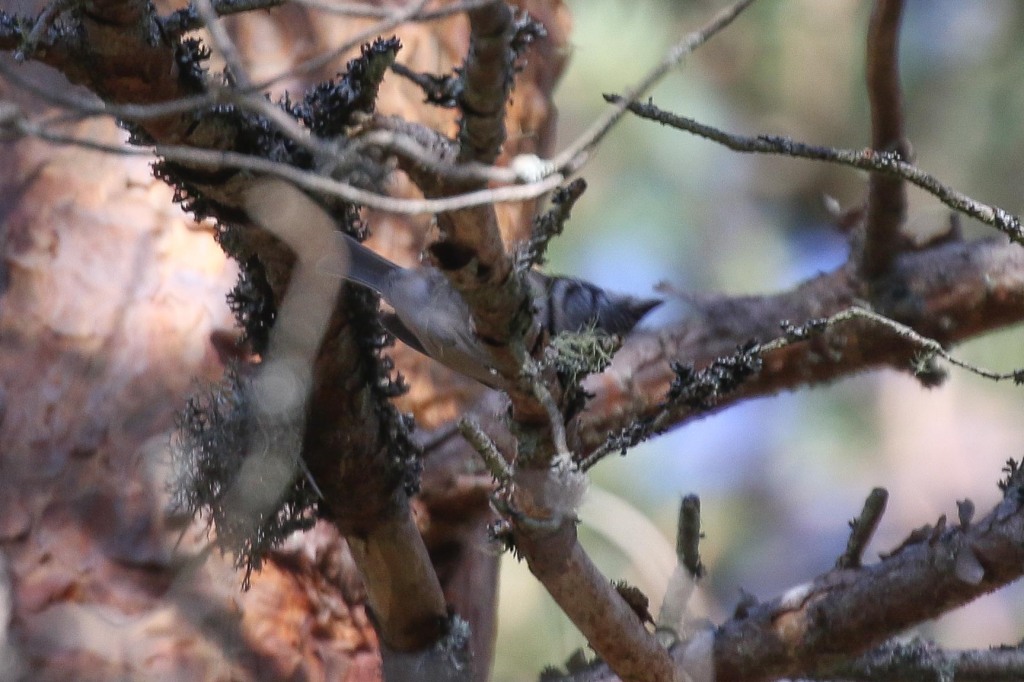
We said goodbye to another member of the group now, who was heading off south, then the remainder of us drove up to the Aberdeenshire coast at Portsoy. After we had drawn a blank the day before, there had been 11 White-billed Divers reported yesterday, 7 off there and 4 off Cullen, so we figured we should be able to find at least one.
It was nice and clear off Portsoy when we arrived, although a bit cooler on the coast than inland. We took our packed lunches up to the benches by the dolphin statue and ate while we scanned. There were a few Eider and Long-tailed Duck offshore, rafts of auks on the sea, and Gannets passing by close in. Scanning further out, we came across several Red-throated Divers and at least six Great Northern Divers, but a diver some way off to the west instantly looked different, long-necked and with its head and bill angled upwards. It was a White-billed Diver, paler-headed than the Great Northerns and its pale bill seemed to disappear against the bright background, but it was very distant.

As we finished our lunch, one of the group picked up a Peregrine on the cliffs away to the west. Then we packed up and drove along the coast to Findlater’s Castle, hoping to refind the White-billed Diver a little closer. There were a couple of Yellowhammers in the fields on the way down to the castle, and Skylarks singing. Scanning from the clifftop, it was a bit misty further offshore now. We picked up yet more Great Northern Divers, including a stunner in full breeding plumage already, but no sign of the White-billed. A couple of Fulmars were flying in and out from the walls of the castle below.
The divers seemed to be gradually drifting west with the tide, so we drove round to Cullen for a quick look just in case. There were at least twenty Great Northern Divers off here now, but likely with some overlap as we picked up the same breeding plumage bird again off to the east. Their grey bills were catching the bright sunshine, and some were looking rather pale offshore in the bright light – easily mistaken for a White-billed Diver by the unwary – but we didn’t have the imagination to turn any of these into something rarer. We would have to make do with just the one today.
Unfortunately, we were out of time now, and we had to set off for the long drive back. After a stop to eat on the way, we arrived back in Darlington late in the evening at the Premier Inn.
Monday 28th March
After dropping off the replacement minibus and picking up ours early this morning, we set off back south. With a quick stop for breakfast at Wetherby, it was an uneventful journey notable only for the rain we drove into on the A1. We had been so lucky with the weather, and now it was turning – next week was forecast to be very cold, wet, windy, and with some snow in the north. Unconcerned by that now, we were back in Hindolveston in time for lunch.
What a great trip. The weather had been fantastic, the scenery was stunning, and the birds were pretty good too. Same again in 2023? We are looking forward to it already!
